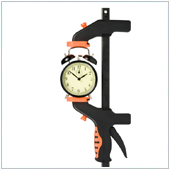 One of the biggest drivers of a company’s success, regardless of the size, is collaboration. If your employees can’t work efficiently together or with external parties, chances of success are fairly slim. This is especially important for small businesses where employees may fill more than one role, often with only a basic understanding of that role, which leads to lower productivity. To make it easier for employees, you can use a program like Microsoft SharePoint.
One of the biggest drivers of a company’s success, regardless of the size, is collaboration. If your employees can’t work efficiently together or with external parties, chances of success are fairly slim. This is especially important for small businesses where employees may fill more than one role, often with only a basic understanding of that role, which leads to lower productivity. To make it easier for employees, you can use a program like Microsoft SharePoint.
SharePoint was launched by Microsoft in 2001 as a document and content management program for intranets - closed networks within a company. Over the past 11 years, SharePoint has added a ton of different capabilities and features that make it an integral part of many business’s infrastructure. One of the biggest advantages of SharePoint is that it integrates with Microsoft Office and Office 365. Here are five things you can do with SharePoint to help make your company and employees more productive.
- Centralize all essential documents. The problem many small businesses face is that files are spread out, normally kept locally on an employee's computer which makes sharing difficult. SharePoint allows you to organize your files in a central location while allowing employees or other parties to access and share these documents.
- Collaboration. With centralized document management, your employees can collaborate easier. No more having to email another employee to get them to send a document then having to compile different versions into one document, as employees will have access to the same document with changes made clearly visible.
- Solidify goals and roles. Employees in small businesses often complain that they don’t know what their roles are and what exactly the company is doing. With SharePoint you can create lists and documents with your goals and expectations of employees, which they can access. Clearly defined goals and roles will go a long way in keeping employees productive because they will be able to see exactly what they should be doing.
- Project management. Project management can be one of the toughest things to keep on top of. One team may be using a separate calendar and documents that other teams don’t have access to causing productivity bottlenecks. With SharePoint you can create calendars and workflows that are shared on the network so you know exactly who is working on what, when it’s due and what’s left to be done.
- Stage-gate implementation. With the combination of calendars, workflow and shared documents you can establish a clearly defined stage-gates, a set point where document drafts, workflow process or any project needs to be approved to move on to the next step. This creates an element of control that keeps projects on track, and necessary parties informed at all times.

 In business, a properly formatted document can go a long ways in showcasing how professional your company is, and often times, is the the main way to set your company apart from other competing entities. If you have a longer document, say a proposal, you’re going to need a Table of Contents (TOC). Instead of struggling to make your own, you can use stylized headings and have Word create one with two clicks of a mouse.
In business, a properly formatted document can go a long ways in showcasing how professional your company is, and often times, is the the main way to set your company apart from other competing entities. If you have a longer document, say a proposal, you’re going to need a Table of Contents (TOC). Instead of struggling to make your own, you can use stylized headings and have Word create one with two clicks of a mouse. Microsoft enjoys a monopoly on Office suites for desktop computers, although where it’s lacking presence is in the smartphone and tablet markets. Because of this, many businesses are stuck without an office suite that allows them to open, create and edit documents on their Android tablets. App developers have realized this and have answered the call.
Microsoft enjoys a monopoly on Office suites for desktop computers, although where it’s lacking presence is in the smartphone and tablet markets. Because of this, many businesses are stuck without an office suite that allows them to open, create and edit documents on their Android tablets. App developers have realized this and have answered the call. There are very few software programs used by nearly every business. One of these programs is Microsoft Office which is available on nearly every major operating system, and has captured a large user base. Word is Office’s word processor and is an integral part of most knowleddge work, yet some struggle to master it. To make using Word even easier, you can use keyboard shortcuts.
There are very few software programs used by nearly every business. One of these programs is Microsoft Office which is available on nearly every major operating system, and has captured a large user base. Word is Office’s word processor and is an integral part of most knowleddge work, yet some struggle to master it. To make using Word even easier, you can use keyboard shortcuts. Think about the worst presentation you’ve even seen. Chances are high the audience was either asleep or completely disinterested. What made it so bad? Was it the presenter or was it the slides the presenter used? More times than not, it’s poorly prepared slides that ruin a presentation. Don’t let this happen to you.
Think about the worst presentation you’ve even seen. Chances are high the audience was either asleep or completely disinterested. What made it so bad? Was it the presenter or was it the slides the presenter used? More times than not, it’s poorly prepared slides that ruin a presentation. Don’t let this happen to you. “Microsoft PowerPoint”, “presentations” and “effective” are three common buzzwords used throughout all businesses. Heard separately, most employees are comfortable with each, but put all three together and a problem appears: Many presentations are simply not effective. Is this true for your organization?
“Microsoft PowerPoint”, “presentations” and “effective” are three common buzzwords used throughout all businesses. Heard separately, most employees are comfortable with each, but put all three together and a problem appears: Many presentations are simply not effective. Is this true for your organization? When we hear someone mention “Microsoft Excel” many of us will instantly think of an open spreadsheet we are working on, or have recently seen. Known by all business owners and managers, and mastered by few, Excel has become one of, if not the, most widely used business applications. While it is a widely used program, there are a number of errors that are confusing. Read on to learn about the most common ones.
When we hear someone mention “Microsoft Excel” many of us will instantly think of an open spreadsheet we are working on, or have recently seen. Known by all business owners and managers, and mastered by few, Excel has become one of, if not the, most widely used business applications. While it is a widely used program, there are a number of errors that are confusing. Read on to learn about the most common ones.
